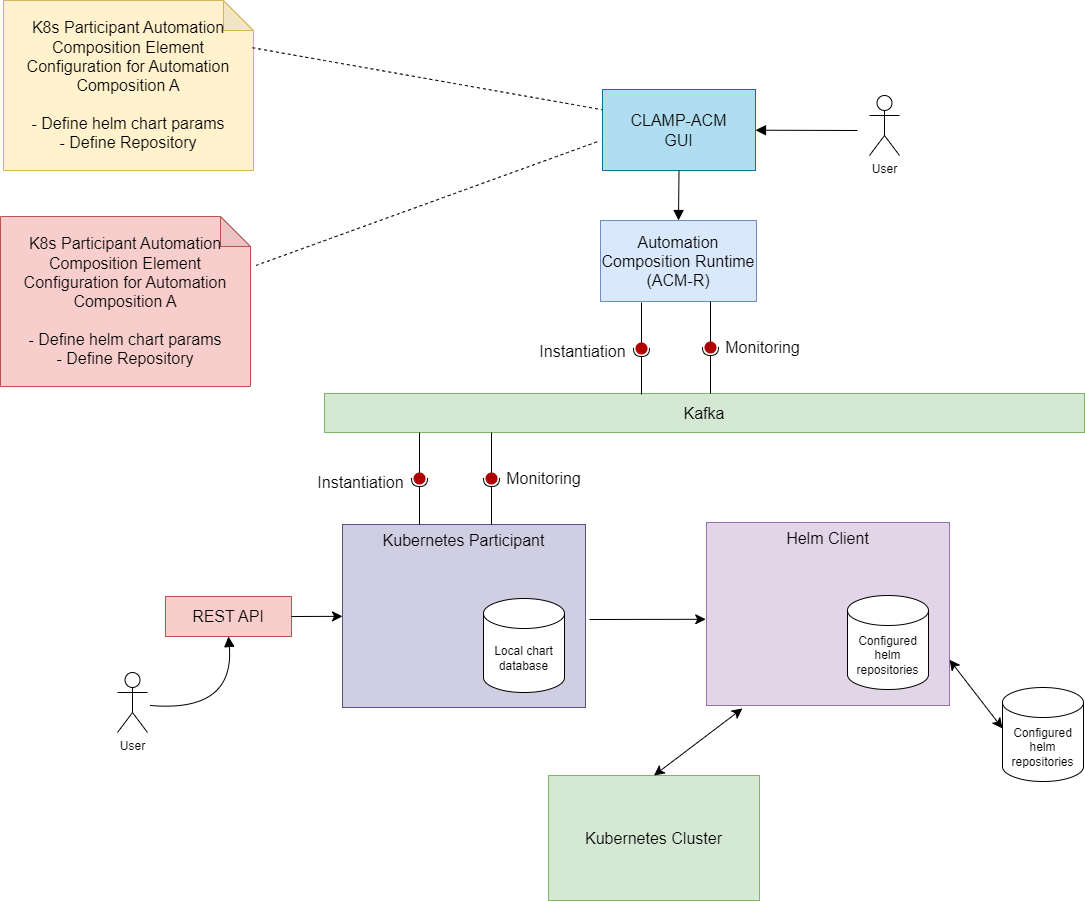Kubernetes Participant
The kubernetes participant receives a helm chart information from the CLAMP runtime and installs the helm chart in to the k8s cluster on the specified namespace. It can fetch the helm chart from remote helm repositories as well as from any of the repositories that are configured on the helm client. The participant acts as a wrapper around the helm client and creates the required resources in the k8s cluster.
It supports the message Broker Kafka.
The kubernetes participant also exposes REST endpoints for onboarding, installing and uninstalling of helm charts from the local chart database which facilitates the user to also use this component as a standalone application for helm operations.
By Kohn version, the kubernetes participant supports the following methods of installation of helm charts.
Installation of helm charts from configured helm repositories and remote repositories passed via TOSCA in CLAMP.
Prerequisites for using Kubernetes participant in Istanbul version:
A running Kubernetes cluster.
Note:
If the kubernetes participant is deployed outside the cluster, the config file of the k8s cluster needs to be copied to the ./kube folder of kubernetes participant’s home directory to make the participant work with the external cluster.
If the participant needs additional permission to create resources on the cluster, cluster-admin role binding can be created for the service account of the participant with the below command.
Example: kubectl create clusterrolebinding k8s-participant-admin-binding –clusterrole=cluster-admin –serviceaccount=<k8s participant service account>

Supported Element Types
Supported Element Types for Kubernetes participant will be used to define the Kubernetes participant Element Definition Types in tosca template. Participant Supported Element Types is defined in Kubernetes participant application.yaml.
participantSupportedElementTypes:
-
typeName: org.onap.policy.clamp.acm.K8SMicroserviceAutomationCompositionElement
typeVersion: 1.0.0
Defining a TOSCA CL definition for kubernetes participant:
A chart parameter map describes the helm chart parameters in tosca template for a microservice that is used by the kubernetes participant for the deployment. A Automation Composition element in TOSCA is mapped to the kubernetes participant and also holds the helm chart parameters for a microservice defined under the properties of the Automation Composition Element.
Sample tosca template defining a participant and a AC element definition. click here
Configuring a Automation Composition Element on the kubernetes participant for a Automation Composition
The user defines the following properties in the TOSCA template for the kubernetes participant:
Property |
Type |
Description |
|---|---|---|
chartId |
ToscaConceptIdentifier |
The name and version of the helm chart that needs to be managed by the kubernetes participant |
namespace |
String |
The namespace in the k8s cluster where the helm chart needs to be installed |
releaseName |
String |
The helm deployment name that specifies the installed component in the k8s cluster |
repository (optional) |
map |
A map of <String, String> defining the helm repository parameters for the chart |
overrideParams (optional) |
map |
A map of <String, String> defining the helm chart parameters that needs to be overridden |
Note: The repository property can be skipped if the helm chart is available in the local chart database or in a repository that is already configured on the helm client. The participant does a chart lookup by default.
The repository type is described in the following table:
Field |
Type |
Description |
|---|---|---|
repoName |
String |
The name of the helm repository that needs to be configured on the helm client |
address |
String |
Specifies the url of the hem repository |
userName (optional) |
String |
The username to login the helm repository |
password (optional) |
String |
The password to login the helm repository |
Sample Automation Composition instances.
In that example the user fills the properties defined in the TOSCA for the Kubernetes participant click here
Kubernetes participant Interactions:
The kubernetes participant interacts with Automation Composition Runtime on the northbound via Message Broker. It interacts with the helm client on the southbound for performing various helm operations to the k8s cluster.
The communication for the Automation Composition updates and state change requests are sent from the Automation Composition Runtime to the participant via Message Broker. The participant performs appropriate operations on the k8s cluster via helm client based on the received messages from the Automation Composition Runtime.
kubernetes participant Workflow:
Once the participant is started, it sends a “REGISTER” event to the Message Broker topic which is then consumed by the Automation Composition Runtime to register this participant on the runtime database. The user can commission the tosca definitions from the Policy Gui to the Automation Composition Runtime. Once the automation composition definitions are available in the runtime database, the user can prime them and further updates the participant with these definitions via Message Broker. After primed, the Automation Composition can be instantiated with the default state “UNDEPLOYED” from the Policy Gui.
When the state of the Automation Composition is changed from “UNDEPLOYED” to “DEPLOYED” from the Policy Gui, the kubernetes participant receives the automation composition state change event from the runtime and deploys the helm charts associated with each Automation Composition Elements by creating appropriate namespace on the cluster. If the repository of the helm chart is not passed via TOSCA, the participant looks for the helm chart in the configured helm repositories of helm client.
The participant also monitors the deployed pods for the configured time until the pods comes to RUNNING state. It holds the deployment information of the pods including the current status of the pods after the deployment.
When the state of the Automation Composition is changed from “DEPLOYED” to “UNDEPLOYED” back, the participant also undeploys the helm charts from the cluster that are part of the Automation Composition Element.